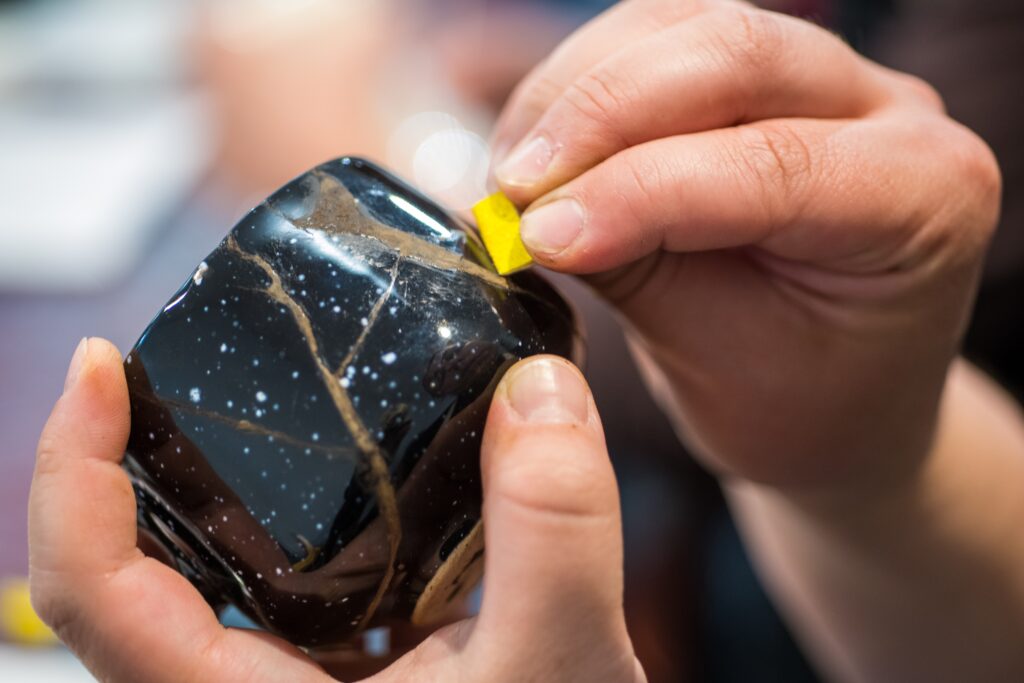| Refresh | This website greator.com/en/kintsugi/ is currently offline. Cloudflare's Always Online™ shows a snapshot of this web page from the Internet Archive's Wayback Machine. To check for the live version, click Refresh. |

In life, good days alternate with difficult challenges. Every crisis - whether it is an illness, an accident, a job loss or a divorce - leaves clear traces in our soul. Kintsugi, a technique originating in Japan for repairing ceramic objects, conveys that our vulnerability is not a weakness, but an opportunity for inner growth.
The Kintsugi method is also called "the art of accepting damage". It is still used today to reassemble broken plates, bowls and other ceramic objects by soldering the fragments. Since gold is used as the soldering material, the end result is a unique object that becomes even more valuable when refined with the precious metal.
While Kintsugi used to be exclusively a technical repair art, today the method has several functions. In the Kintsugi meaning is distinguished between the craft method and the philosophy of soul healing. Experience has taught that even psychological "fractures" can be repaired and valuable insights can be gained from negative experiences. On the psychological level, the Kintsugi technique is used to cope with complicated situations and to start again strengthened after a crisis.
In Japan, Kintsugi is a traditional practice. The process has been used for centuries as a repair method for ceramic or porcelain fragments. Liquid gold or silver is used for repair. After the fragments are put together, each plate or bowl has different, individual aspects.
A Japanese legend describes that this particular method of repair originated in the 15th century when the shogun (leader) Ahikaga Yoshimasa broke his favorite tea cup. As a result, craftsmen were commissioned to repair the favorite cup so that it could be used again.
The artists mixed varnish with gold dust and ensured with their craftsmanship that the cup subsequently became a unique and more valuable object of use. In the Kintsugi method, it has since been assumed that the end result is always unique. Kintsugi for the soul is also based on this knowledge.
Kintsugi psychology describes that there are some similarities between repairing a defective object and processing psychological wounds. Thus, psychological scars that have arisen due to unpleasant experiences, traumas or other problems should not be repressed, but emphasized. The point is to gain new perspectives in order to better process the pain.
Kintsugi wants to help you to Past Reconcile by picking up the pieces of your life and putting them back together. When you respect your own vulnerability, new connections of meaning can emerge. Your experiences are an important treasure that gives you strength for the future. At the same time, the connection between the past and New as a source of inspiration.
Our resilience (Resilience) depends on whether we are able to deal with negative experiences and grow inwardly from them. The Kintsugi method sees itself as more independent, patient Observer. A blow of fate can also have positive perspectives. Kintsugi teaches us to see the beautiful things even in the negative.

We like to repress traumatic experiences because it is difficult to deal with them. Mental wounds can hurt just as much as physical injuries. Our soul does not forget anything. Sometimes trauma only comes to light decades later in the form of Fears, addictions or physical illnesses resurface.
Without our active cooperation, however, an old wound cannot heal. Suppressing worries through distraction or the consumption of pleasure toxins such as alcohol or nicotine is of little help. This does not solve the problems. A crisis in life brings to light truths that have existed for a long time but that you have not paid attention to.
Every human being carries psychological injuries within him or her. Some cracks are tiny, while others can be so deep that we ourselves are unable to forgive and forget. We deal with difficult life events in very different ways. Therefore, it is not uncommon that we even try to hide scars on our soul from others.
However, we cannot fool ourselves. Unresolved conflicts remain until we are ready to face the challenge and work through the problems.
Kintsugi symbolizes the art of ceramic repair on the one hand, and is a method of healing emotional injuries on the other. When repairing ceramic pieces, you putty the broken areas with gold. This leaves the broken areas visible and even highlights them, making them an original one-of-a-kind piece.
Ceramics is a non-metallic material that symbolizes fragility, beauty and strength, and thus has similar characteristics to humans. In Kintsugi, it is believed that just like ceramics, our lives can also break. And just like damaged ceramics, broken pieces of life can be put back together if you know how.
Do you feel weak and vulnerable? Have you not yet been able to heal emotional wounds? When the memories of events long past, Trauma or offenses are too terrible, Kintsugi can be a support to cope with the great pain.
More interesting details about the Japanese art you can learn in this Video with Tobias Beck.
Behind the Kintsugi philosophy is an idea that says to accept and appreciate imperfections. The new perception that arises from this is also called Wabi Sabi. This term comes from Zen Buddhism and means that there is beauty in every aspect of imperfection.
As a philosophy of life, Kintsugi is based on the ceramic repair method of the same name. The way of thinking arises from the parallelism between the visible fractures of repaired objects and the perceptible spiritual wounds of life.
With their craftsmanship, the Kintsugi masters transform damaged ceramic objects into new, even more spectacular objects with the help of gold or silver paint. Perfection is not what matters here. Uniqueness and distinctiveness play a greater role in the Kintsugi philosophy. One sees in every stumbling block in life not an obstacle, but an opportunity to grow and develop.
In Kintsugi, it is believed that all things are unique, as is each person, and that a break does not mean the end.
The method teaches that:
With attention and love, a much stronger, new concept emerges from a broken life plan. In Japanese craftsmanship, similar to the Kintsugi philosophy, qualities such as patience, accuracy and courage are valued. Courage is necessary to face the challenges in life. At the same time, coming to terms with one's past means engaging in a long process.
Even a repair carried out using the Kintsugi technique often takes weeks or months. When puttying fractures, attention is paid to every tiny detail, and special requests from the customer are taken into account. From the Kintsugi process came the philosophy that we can always give our story a new, different context of meaning. Just as a vessel changes when it is repaired by taking on a new shape, our lives change when we actively bring about change.

From repairing broken ceramic pieces with the help of gold powder, we can learn a lot about how to deal with problems. Kintsugi is, above all, a remarkable art. The artisanal process allows damaged pieces to become even more valuable and precious after repair.
Think of the Kintsugi method as a metaphor for your life. It is your broken places, your mental scars or your imperfections that make you a strong personality. When you feel buffeted by fate, you can pick up your broken pieces, caress the cracks, and learn to put them back together.
Being vulnerable is perfectly okay. Kintsugi teaches you to be loving and attentive to yourself, and to be comfortable with your strengths and weaknesses to accept. Often Kintsugi is described as a practice of self-love. But the philosophy also has something to do with Forgive and forgiveness.
In order to accept your mistakes, you must first love and respect yourself. Then you will be able to forgive other people who have caused you mental pain. Kintsugi teaches us:
Mental toughness is a skill you need on the job to successful to be. If you want to become mentally stronger, examine your personal beliefs and attitudes. Changing the way you think can go a long way.
Look at things from different perspectives before you make a decision. This is how you master even difficult situations and deal with stress more calmly um. Overcoming setbacks more easily means simply getting back up after "falling down" and starting over again. Another lesson we can learn from Kintsugi is that it is possible to repair damage and even improve the overall work in the process.
In terms of life, the message that Kintsugi conveys is: You are unique and have all the prerequisites within you to emerge strengthened from a crisis!



